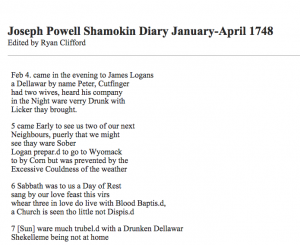The process of marking up has introduced a whole new realm of close reading that I was unaware of. When analyzing almost every word and deciphering them into categories, you can gain a new and deeper understanding of the text rather than simply reading it in print, which is what Pierazzo talked about in her article. She compared digital and print editions of primary and secondary sources, and determined that there is a lot more one can do digitally. She also talked about how editors may abuse the internet’s features and don’t know where to stop. For our class, we went through a series of mark-ups that began with color-coding our transcription based on people, places, and events among others. Then we proceeded to implement the specific codes for these categories, which required a lot of attention and precision. Finally, we published our corrected editions of our transcriptions from Oxygen on the internet, something no other class has ever done before.

At first I struggled to move past the basic and elementary aspects of marking up that followed the color-coating part. It was difficult to decide whether to mark up a place or object more specifically, especially the states and traits. I was lazy with these and didn’t expand on them, and for that I was due for a number of corrections. Upon seeing these corrections from Prof. Faull, I was able to understand how carefully I should’ve done these mark-ups, for now they are published on the internet for all to see. It was also helpful to have the collaborative database amongst my classmates to ultimately decide what to do with certain ambiguous mark-ups. For example, we as a class decided to change a thorn to “th” and we also maintained strikethroughs and underscores. As Pierazzo writes, we as scholars “are competent readers, and if we mutually agree on something then it is by definition objective”, and that “scholarly choices constitute the base of any transcription and subsequent diplomatic edition” (Pierazzo 466). It was up to us to make definitive choices that become universal amongst ourselves, so we were working as a team to have similar mark-ups so that it would become easier to look at for others.

“The process of selection is inevitably an interpretive act”, so an editor can decide how extensively he or she wants to analyze a text (Pierazzo 465). If one chooses to look at a certain person or event more closely, then he or she will gain a deeper understanding of how that word contributes to the greater text. Someone can either interpret a person for simply his or her name, or he or she can for instance interpret that person for his or her role in the community. There is always more to analyze about various elements in a transcribed document, which comes back to the concept of where do we want to stop? I feel as though we did a fine job of marking up and setting checkpoints so that we do not do too much yet we have a greater understanding of our particular pages of the Powell Diary.